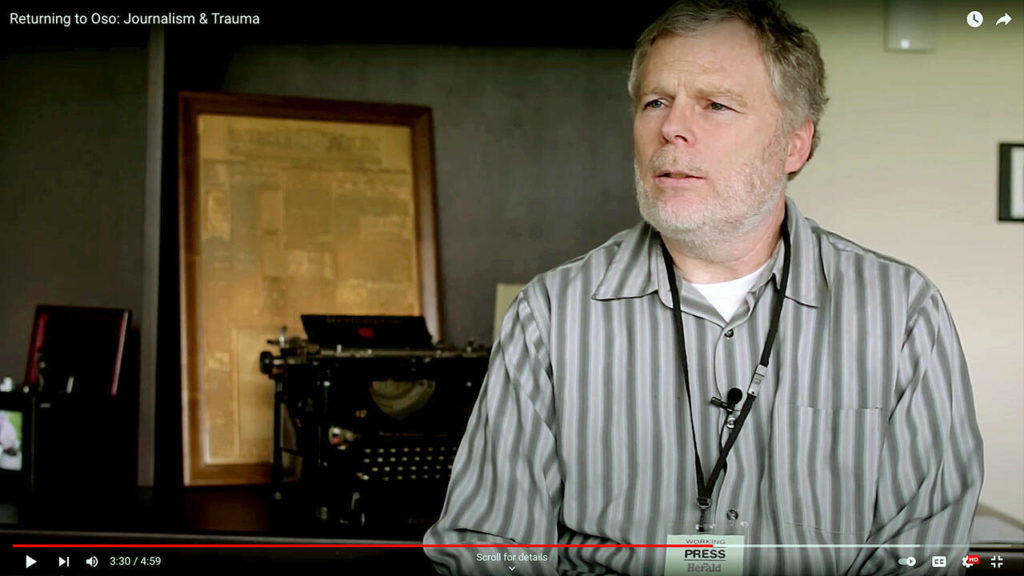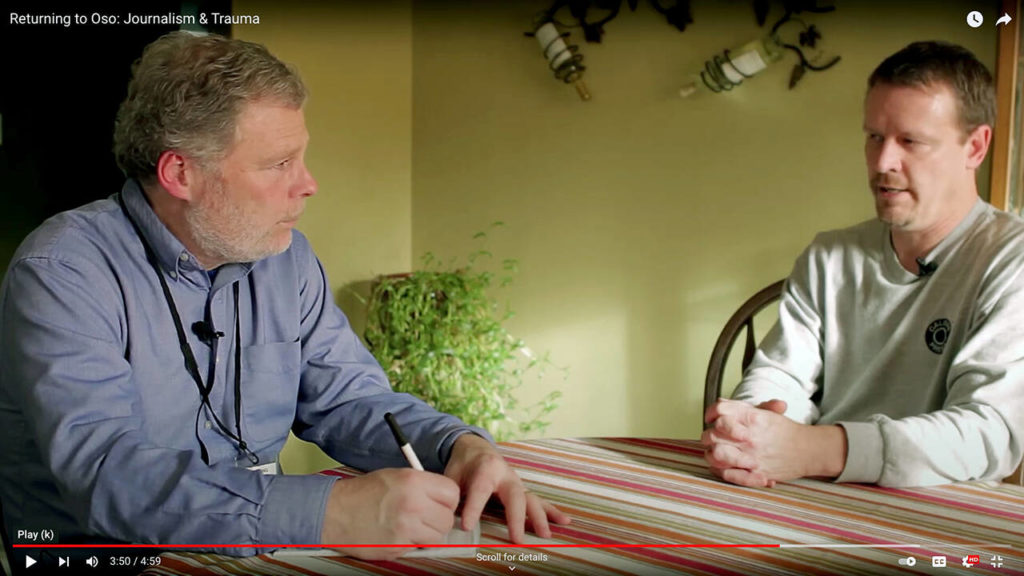More than 40 years and thousands of bylines later, I can count on one hand the number of times I have written a newspaper article in the first person.
This is the fifth, and will be my last.
I retired Friday. You’ll have to keep reading to find out why now and what’s next.
Over the years, most of my newsroom colleagues have left the business for a litany of valid reasons: better pay and benefits, shorter work days, more predictable hours, less stress, uninterrupted weekends and greater job security top the list. Then there’s the unrelenting grind of deadlines that come with putting out a product in print and online seven days a week, 365 days a year, year after year, as certain as the tides.
Right or wrong, I consider myself to be among the fortunate few to have reached the finish line in a profession I have loved since my days in The Daily Evergreen newsroom at WSU. The journey led me from an internship in Wenatchee to a small weekly in Southwest Washington to seven years at The Daily World in Aberdeen to 31-plus years and 11,407 editions at The Herald.
Why, I sometimes wonder when cynicism gets the best of me, did I stick with it so long?
I then remind myself of the thousands of people who have entrusted me and my colleagues with their stories, sometimes under the most challenging of circumstances.
And I am grateful and at peace. They have given my work life meaning. They are why I stayed.
Journalism has fed my needy curiosity generously. It has revealed to me again and again and in myriad ways how much people care about family, friends, community and mankind. I never did manage to outgrow the naive idealism of my youth, and still believe that being a tiny cog in a free press in a free country is a worthy life calling.
Join me for a moment as I return to a lobby in downtown Wenatchee. It is a Thursday night in November 1981. The man sitting across from me is Don Newcombe, once a teammate of Jackie Robinson and one of the early African-American players to break the color barrier in Major League Baseball. He was the first pitcher to receive the Rookie of the Year, Most Valuable Player and Cy Young awards over a career. He was the first Black pitcher to win 20 games and the first to start in a World Series.
He also was an alcoholic, which is what brought him to Wenatchee for a speaking engagement. At rock bottom, he went broke, nearly lost his family and sold a World Series ring for drink. He ultimately gained and maintained his sobriety and spent much of the rest of his life trying to help others do the same.
I didn’t bother him for an autograph. He looked tired, and it didn’t seem ethical. The memory of that evening was reward enough.
As I flip through old clippings — the good, the overwrought and the cringe worthy — I return in my memories to the living room of a soon-to-be octogenarian in the tiny town of South Bend. Helen Davis is a spry widow in 1985 and she is mounting her best defense of “Washington, My Home,” the wholesome lyrics she proudly penned that were adopted as the state song in 1959. What had started out as a tongue-in-cheek campaign to replace her magnum opus with the rock ’n’ roll classic “Louie, Louie” seemed to be gaining traction.
She is seated at her piano bench, singing:
Our verdant forest green,
Caressed by silvery stream;
From mountain peak to fields of wheat.
Washington, my home.
To her credit, Davis concedes “Louie, Louie” has a catchy beat, but she argues its lyrics fall short.
Louie Louie, oh no
Me gotta go
Aye-yi-yi-yi, I said
Louie Louie, oh baby
Me gotta go
A week ago, I lugged a large plastic crate containing old newspapers out of the garage and brought it to the dining room table. The stacks within are like geological strata, covering different eras from the 1980s to present day.
I am soon reminded of a trip to the prison in Shelton where I interviewed an inmate with learning disabilities who had pleaded guilty to an armed robbery he had not committed. He explained he did so to take advantage of a plea bargain that offered a shorter sentence than what he likely would have received if convicted. A Grays Harbor detective tipped me off, figuring a reporter asking questions might speed up the process of setting an innocent man free. He was right. A few months later, I was in the courtroom when the man who actually committed the robbery admitted his guilt.
I thumb through a series written in the 1980s with three other reporters I consider some of my closest friends to this day. That’s the thing about newsrooms: people come and go, but friendships endure. The stories examined what was killing coho salmon on the Chehalis River. The package cost two pulp mills millions of dollars to overhaul their inadequate wastewater treatment systems.
I explore another layer. It is from the early 1990s and I am a husband and father now, having made the move from Aberdeen to Everett.
I am at Don’s Restaurant on Fourth Street in Marysville and over bacon and eggs, toast and coffee, listening to Tulalip chairman Stan Jones explain treaties, his culture and what gambling could some day mean for the tribes. I am at the tribal cemetery after an elder medicine man has passed. I am travelling near and far to interview the last of a generation whose first language was Lushootseed, elders who recognized much needed to be done to save the endangered words of their ancestors.
By the late 1990s, I am visiting hundreds of classrooms while covering the education beat for 15 years. I now scan an eclectic mix of stories: the girl who made her prom dress out of duct tape, the valedictorian who is deaf, the diminutive homecoming king with cystic fibrosis who returns from the hospital in time for the big game and halftime coronation, the crusade of Debra Howell and her elementary school students in Granite Falls who made Vietnam War veterans finally feel welcomed home, decades after they returned. I muse at a reference to cow pie bingo, one of many grassroots events that helped raise the millions it would take to build the Linda Byrnes Performing Arts Center at Arlington High School.
There are stories written with other reporters on weighty topics: a five-part series in 2005 outlining how school districts locally and statewide grossly undercounted the number of students who dropped out or failed to graduate high school; articles on the good and bad of state standards and testing that tried to add accountability and even the playing field but raised questions of fairness; an analysis of why girls consistently outperformed boys in every subject at every high school in the county; coverage of the state record 49-day teachers strike in Marysville and the financial implosion that followed.
With some trepidation, I revisit the 2014 Oso mudslide and the 43 lives taken that soggy March morning. I am reminded of the courage and precision involved in the Day 1 rescues and the selflessness and determination of the recovery efforts. The undertaking was massive yet somehow tender. It took four months to find the last of the missing.
My memories of those months are too numerous to recount here, and some details are probably too personal for those involved. There can be a fine line between telling the stories of those lives lost and exploiting the grief of shell-shocked loved ones.
I relive just one story. I am in Darrington watching Dayn Brunner head out toward the vast wasteland. He’s looking for his sister, Summer Raffo, whose Subaru was swallowed up in the mud along with an uprooted stretch of Highway 530. Sometimes his son, Riley, joins him in the mire. Dayn called me five days after the slide to let me know Summer had been found. He wanted to share how grateful he was to those who helped find her and how gracious they were to give him time and space to mourn.
At his invitation, I attended Summer’s memorial with pen and notepad. A year later, I was at Riley’s high school graduation, without my notebook.
That October, I am on the sidewalk outside the firehouse a little ways down 108th Street from Marysville Pilchuck High School. I hear the wails from within those walls. They belong to the families of the children shot by a classmate in the school cafeteria. To this day, I cannot shake the sound of grief so deep and raw. Nor should I.
I remember walking down 51st Street to a church parking lot that served as a reunification site for MPHS students and their parents. My own children were students there a few years before. My house was 2 miles away. I recognized many of the students as younger siblings of my daughter Katy’s classmates. Some of the parents were family friends. I watched their relief as they hugged their sons and daughters, but the sounds from the fire hall echoed in my brain.
Toward the bottom of my archival mound are stories from our county’s past: historic buildings razed, burned or lovingly restored, and presidential visits to Snohomish County.
I drift back in my memories to the Everett Public Library where Lisa Labovitch in the fall of 2016 shared copies of little-known documents she brought back from the special collections section of the University of Michigan library. On the eve of the centennial, they provided remarkable new insights into the 1916 Everett Massacre, the showdown on the city’s waterfront that killed a deputy sheriff, a National Guard lieutenant and five members of the Industrial Workers of the World labor union.
That’s the official death toll, anyway. David Dilgard, a regional historian from the library, would describe to us an interview many years earlier he had with a retired Everett police officer who said the bodies of six other Wobblies had been fished out of the bay, wrapped in canvas, weighted down with chains and deposited in deep waters off Mukilteo. I can only hope that reporters for the next 100 years will continue to dig into what really happened that day.
Another 2016 clipping reacquaints me with Percy Z. Brewster, the Sultan town marshal shot and killed while trying to place a suspect in the town’s jail in March 1927. His story had largely been forgotten in the Skykomish Valley. To reconstruct what happened takes searching microfilm at the courthouse, sifting through library and state archives and tracking down a Gold Bar man who’s Brewster’s grand nephew and can provide family photos and oral history.
Aloha Zurfluh, the caretaker at the International Order of Odd Fellows Cemetery in Monroe, was kind enough to help me find Brewster’s grave marker. It took us several minutes to make out the faded letters on his spartan burial vault. There is no mention that he was a town marshal slain in the line of duty. Zurfluh told me at the time that she’d lived at the cemetery for 50 years and she’d never known anyone to look for Percy Brewster.
For some time after reading the story, the idea of Brewster’s forgotten legacy troubled Monroe Police Cmdr. Paul Ryan, who believed the Sultan lawman deserved better. In May 2020, Ryan and Chief Jeffrey Jolley went to Brewster’s grave site to see for themselves and later reached out to their community for help.
Ryan sent me an email update this summer: “I’m pleased to see this project to its end, and happy Percy’s grave is properly and respectfully marked, a tribute to his service.”
Within the image of a star-shaped badge at the top of his new headstone, his identity is restored: Town of Sultan Marshal. Beneath the star in raised gold-colored lettering, reads his epitaph: “A day of duty done, a day of rest begun.”
I pull out three last stories. They remind me of my son, Ian, now 31 and living in a group home in Shoreline. Ian is non-verbal and on the more profound end of the autism spectrum. I wrote several pieces over the years about children on the spectrum and the challenges their families faced. Perhaps, it was catharsis or therapy, but I could relate to the parents and they could relate to me.
One front page brings me back to a 2012 Friday night football game at a rain-soaked Everett Memorial Stadium. After the final whistle, the Cascade High team captain took the hand of his Bruin Buddy, Lucas Jauregui, then an 11-year-old non-verbal boy who smiled with delight. They walked off the field toward the locker room. Three months earlier, Lucas would turn his back and pick at blades of grass, unwilling to meet Steven Gallardo’s friendly gaze. It was a short walk and a simple gesture, but a milestone to Lucas’ family.
A 2013 story takes me back to the Comcast Arena where one of the Glacier Peak High School graduation speakers is Nick Eveland. Midway through his junior year, no one knew their classmate with Asperger’s syndrome, an autism spectrum disorder that includes many of the social and behavioral impairments of autism, except for difficulties with language. He’d been largely invisible, walking to his classrooms when the hallways were empty and steering clear of the cafeteria and all-school assemblies to avoid sensory overload. Eveland, who loves music, emerged from his shell to win roles in student plays and explain to his classmates the loneliness his condition can cause. He found kindness and acceptance, as well as a date to senior prom.
The last clipping is from 2017. It is about Jessie Pyles, then a nonverbal 7-year-old boy whose parents tried every way imaginable to help him communicate, including letting him write on walls inside and outside their home with chalk and magic markers. I would have done the same with my son if it would have helped him express himself.
It is time to go. The past three years as local news editor have left me enthused and strangely energized. I’d be willing to return my AARP card to anyone who would take it. To the very end, I looked forward to work each day and would glance around the newsroom at my colleagues and be filled with hope.
At the beginning of this article, I promised those who read to the end that I would explain the timing of my decision to retire.
The superficial answer is I want to spend more time with my family.
That is true, as far as it goes. The reality is my wife, Donna, has been living with ovarian cancer for five years. We first met in the student newsroom in 1979. She has put up with my long hours, crazy schedule, missed dinners and early and late night calls with patience and understanding for more than 40 years.
I have packed up and slipped the crate of old clips back onto its shelf in the garage where they will stay.
It will be good to be home.
Talk to us
> Give us your news tips.
> Send us a letter to the editor.
> More Herald contact information.





























